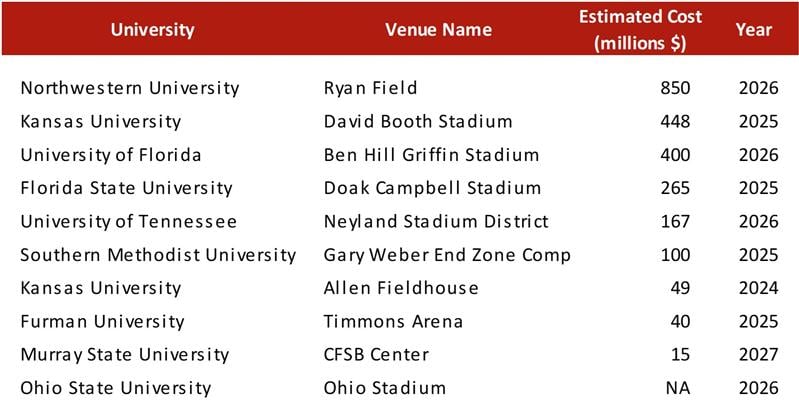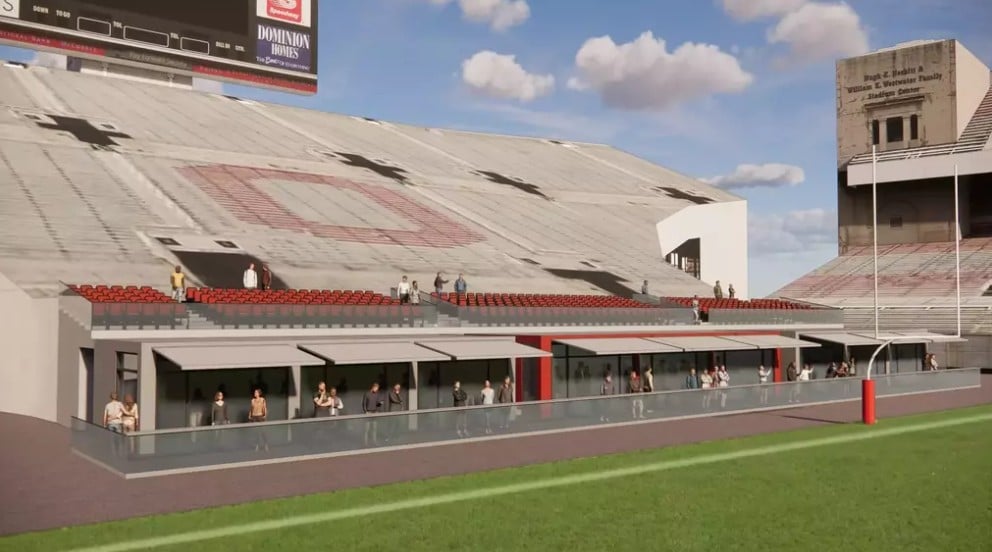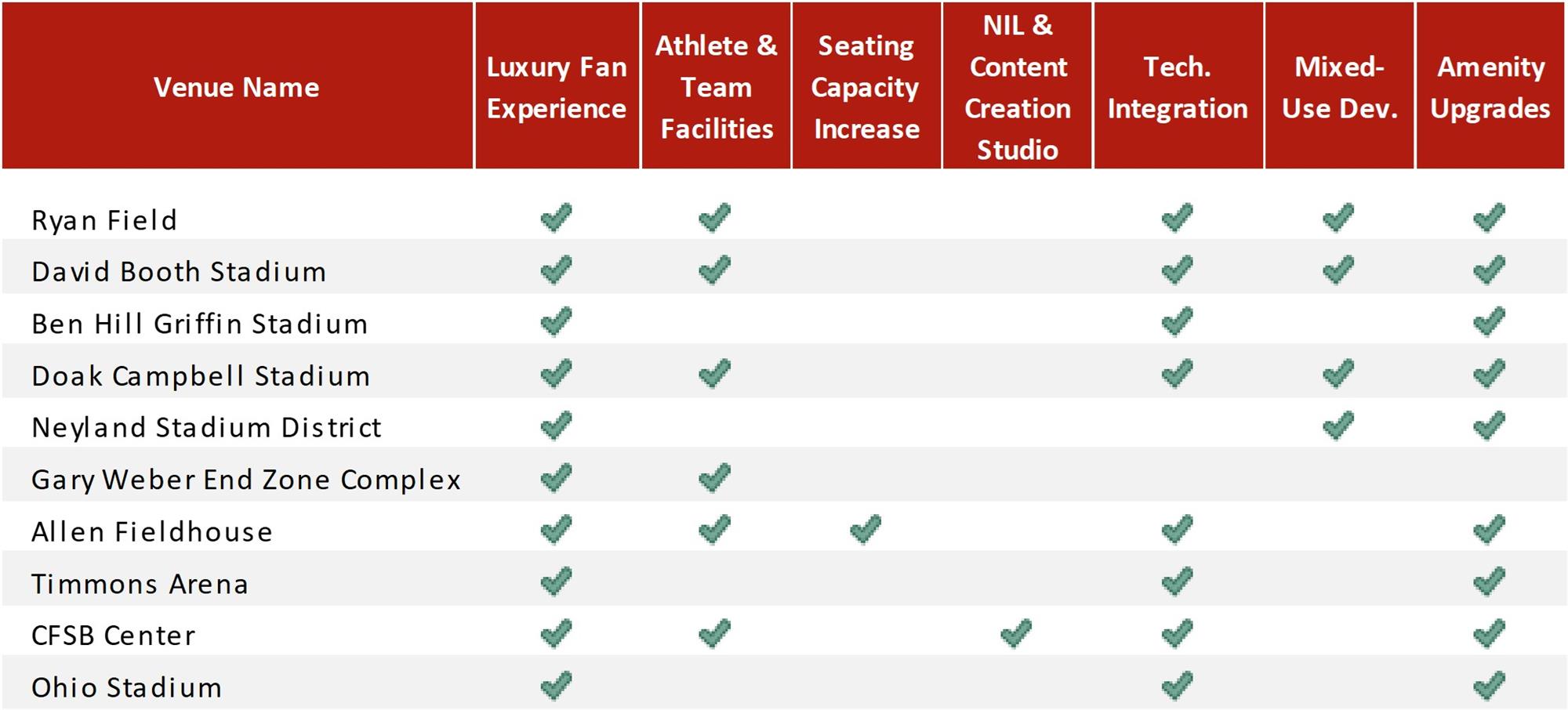
The college sports landscape changed forever on July 1, 2021, when the NCAA implemented an interim policy allowing college athletes to profit from their name, image, and likeness (“NIL”). This shift fundamentally altered the economics of college sports. What began as a limited opportunity for student-athletes to profit from endorsements has evolved into a billion-dollar ecosystem influencing recruitment, competitive balance, and institutional investment. NIL market spending hit an estimated $1.17 billion in 2023, with booster-funded collectives accounting for nearly 70% of this activity.[1] An NIL collective is a donor-funded group that helps college athletes earn money from their name, image, and likeness.
As the financial dynamics of college athletics continue to evolve, universities are increasingly incorporating NIL considerations into facility planning and development. Many new and planned projects emphasize spaces that support content creation and generate revenue opportunities. Beginning with the 2025–26 season, schools will be permitted to make direct payments to athletes of up to $20.5 million annually. NIL-NCAA.com projects that NCAA Division I athletes will receive approximately $2.25 billion in total NIL and revenue-sharing compensation during the 2025–26 academic year.[2] This change will significantly reduce reliance on booster-funded NIL collectives going forward. What impact will this have on stadium and arena development in college sports? Will revenue generation become the primary focus in athletic facility design now that schools will be paying players?
New College Facility Development Projects
To begin to answer these questions, we examined recent trends in collegiate stadium and arena development. In 2025, completed college stadium projects are expected to reach a record $2.4 billion, doubling 2024’s total and surpassing the previous record set in 2023 by half a billion dollars. This record is unlikely to stand for long, as 2026 projections estimate the annual total will exceed $3 billion. Arena development is also experiencing a surge at the college level, with 2025 projected to exceed $1 billion in total arena projects, marking only the second time this threshold has been reached. 2025 will see 58 college stadiums and 27 college arenas open, compared to 53 and 19, respectively, in 2024.[3]
Across the country, college stadium development seems to be ramping up. The following table is a non-comprehensive list of major improvements recently planned or completed in college sports.

Sources: Respective Universities
Several major projects are underway, with more in the pipeline for the coming years. Northwestern University’s new Ryan Field project leads the way in spending, at approximately $850 million. Other major projects include University of Kansas' rebuild of David Booth Stadium, the University of Florida’s stadium renovation to be completed in 2026, and Florida State’s recent renovation of Doak Campbell Stadium. However, major college facility upgrades are nothing new. We need to dig deeper to find whether the characteristics of these projects have changed since the dawn of NIL and revenue sharing.
In a 2024 press conference, Tilman Fertitta, University of Houston System Board of Regents chairman and owner of the Houston Rockets, said:
This perspective is evident in the collegiate facility development space, where many universities are questioning where the balance is between NIL payments and facility development. The Ohio State University’s Athletic Director Ross Bjork discusses his approach to the new landscape of college athletics and revenue sharing on Next Up with Adam Breneman:
Performance remains a priority, and college facilities will continue to deliver top-tier resources for player development. However, Bjork seems to suggest that some of the extra bells and whistles seen in past years may give way to a sharper focus on revenue generation. With the advent of revenue sharing in college sports, institutions must now balance athlete performance with financial sustainability. This shift could bring facility planning closer to the NFL model.
In professional sports, facilities tend to emphasize functionality and revenue efficiency over grandeur, supporting both team performance and player compensation. A similar trend may be taking shape in college athletics. At Ohio State, for instance, the football stadium will debut new field-level premium seating in 2026, including access to the team tunnel and the new 1922 Club. This addition is part of a broader effort to enhance the fan experience, but has been prioritized for its strong revenue-generating potential.
Ohio Stadium Premium Seating Rendering

This emphasis on premium amenities is taking form nationwide. Florida State University’s latest renovation introduced club and suite seating positioned closer to the field, replacing traditional seating with more engaging, high-value options. Murray State’s renovation of the CFSB Center will feature a new “courtside bunker club,” giving basketball fans a premium, up-close experience to the action.
Changing Venue Characteristics
How common is this emerging theme? Key features of recent major stadium and arena improvements in college sports indicate how these developments are changing. The following are features of stadium and arena renovation projects.
- Luxury Fan Experience — Clubs, suites, loge boxes, ledge seats, hospitality lounges.
- Athlete and Team Facilities — Locker rooms, rehab, staff offices, nutrition areas, hydrotherapy, player development, and academic spaces.
- Seating Capacity Increase — Additional general seating to raise overall capacity.
- NIL and Content Creation Studio — Dedicated spaces supporting NIL-driven photo/video production.
- Technology Integration — Upgraded A/V, LED boards, sound systems, connectivity.
- Mixed-Use or District Development — Hotels, entertainment districts, restaurants, retail.
- Amenity Upgrades — Concessions, food & beverage improvements, fan experience enhancements.
The following table provides more detail on some of the recently completed or planned improvements colleges have made to their athletic venues.

Sources: Respective Universities
Luxury fan experiences and premium seating options are the most common features among recent and upcoming college sports facility developments. As one of the highest revenue-generating components of a stadium, these additions align with the growing emphasis on revenue generation following universities’ new ability to make direct payments to players. Except for Kansas’ Allen Fieldhouse renovation, increasing overall seating capacity does not appear to be a focus. Instead, many schools are concentrating on adding premium seating to maximize revenue potential. Some of these projects have reduced overall capacity, replacing general seating with higher-value premium options.
While the past decade of college athletics resembled an arms race marked by improved player facilities and locker room enhancements, recent and upcoming projects show a shift away from that focus—consistent with comments made by Ohio State Athletic Director Ross Bjork. Technology integration and fan amenity upgrades remain key features, as programs seek to modernize their venues and improve overall spectator experience.
A notable emerging feature is the inclusion of dedicated content creation studios, primarily supporting athlete and NIL-related media. Opening in 2023, the Clemson Athletics Branding Institute appears to be one of the first such examples—12,000 square feet of photo, video, and audio studios alongside an NIL Coordinator office. The University of Kentucky recently completed its Downtown Studio in the Central Bank Center, which features similar production and content-creation facilities. Murray State’s renovation of the CFSB Center includes a new NIL Studio located just steps from the player locker rooms.
Mixed-use development is another rising theme in college athletics. Projects such as the Kansas Gateway and Tennessee’s Neyland Entertainment District incorporate hotels, restaurants, and retail into the stadium environment. Florida State’s Doak Campbell Stadium includes a public bar and restaurant accessible from outside the stadium during games.
Ultimately, these trends reflect a broader movement toward revenue optimization and a business model more closely aligned with professional sports. Universities are starting to examine ways to retain more revenue from gameday visitors.
Conclusion
The evolution of NIL and the introduction of revenue sharing are fundamentally reshaping how universities approach athletic facility planning and stadium development. The price tags for recruiting college athletes are only going up, and with them, the focus of stadium development is shifting toward revenue-generating opportunities. In this new era, success in college athletics will increasingly depend on a program’s ability to generate, manage, and reinvest its own revenue in players. It is possible that these trends will further widen the competitiveness gap, as smaller universities may lack the resources to invest in major revenue-generating initiatives and match the athlete compensation levels of larger programs. Few things are certain about the future of college sports, but the next five years will be among the most pivotal in shaping it.
[1] “NCAA Revenue Sharing & NIL Estimates 2025”, Retrieved October 28, 2025.
[2] See note 1.
[3] Sports Business Journal, “ Record Spending Seen on College and Minor League Venues Set to Open in 2025”, Retrieved October 28, 2025.
[4] Houston Chronicle, “ UH Needs to Stop Building and Pay Players”, Retrieved October 28, 2025.

0 Comments
Success
It will be displayed once approved by an administrator.
Thank you.
Error